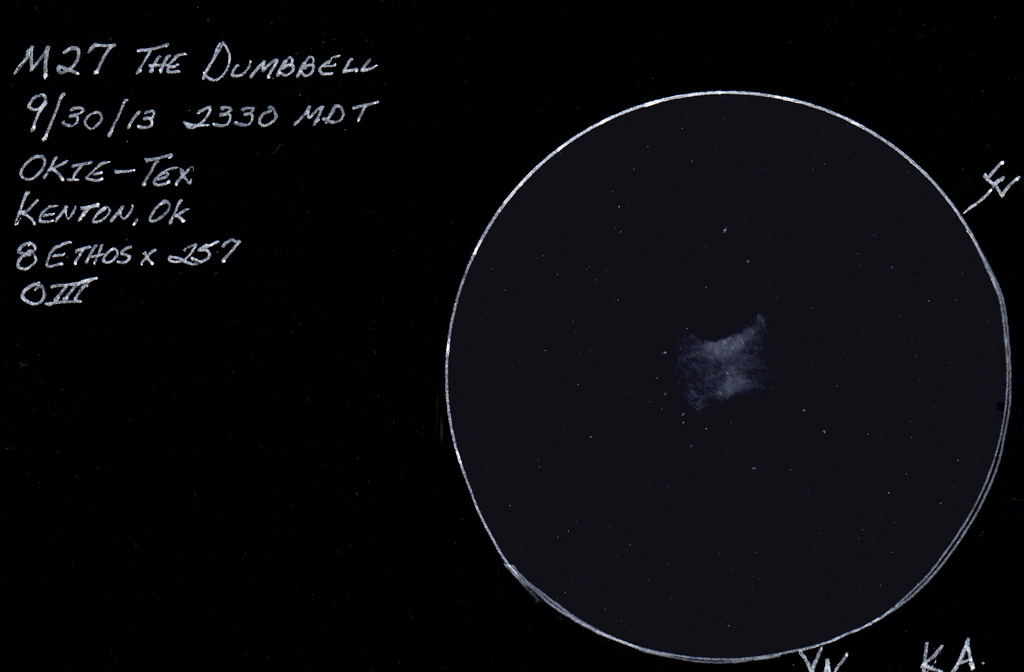
Object Name: M27
Object Type: Planetary Nebula
Location: Kenton, OK (Okie-Tex Star Party)
Date: 30 September 2013, 2330 MDT
Media: Black paper, conte crayon, pencil and ink
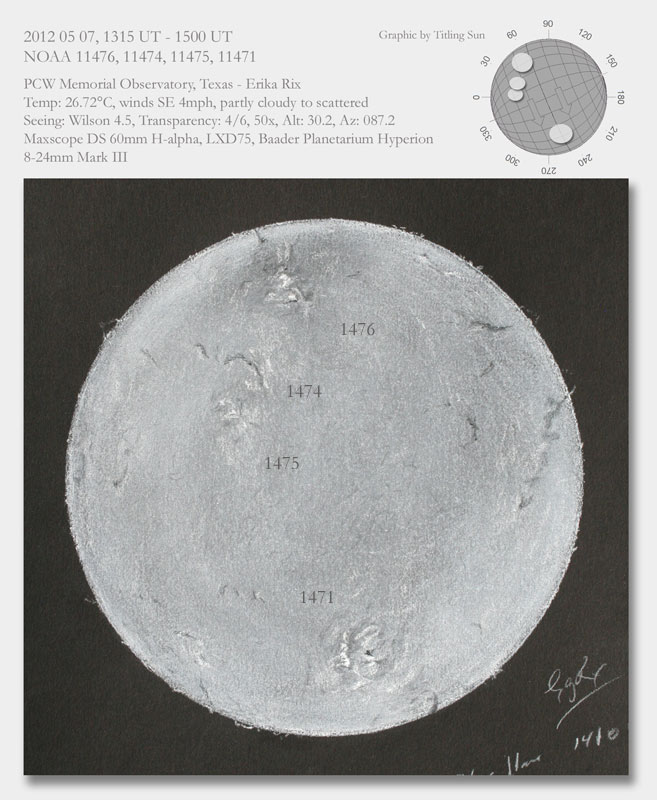
2012 05 07, 1315 UT – 1500 UT.
NOAA 11476, 11474, 11475, 11471.
PCW Memorial Observatory, Texas – Erika Rix
www.pcwobservatory.com
Temp: 26.72°C, winds SE 4mph, partly cloudy to scattered.
Seeing: Wilson 4.5, Transparency: 4/6, 50x, Alt: 30.2, Az: 087.2.
Maxscope DS 60mm H-alpha, LXD75, Baader Planetarium Hyperion 8-24mm Mark III.
Sketches created at the eyepiece with black Strathmore Artagain paper, white Conte’ crayon and pencil, white Prang color pencil, Derwent charcoal pencil, black oil pencil.
I’ve really been enjoying the current set of active regions the past few days. It would be nice to sketch each individual active region as a close up view, but to do that would take several hours. As it was today, I struggled with a group of thick clouds for the first hour of my session. The sky was crystal clear when I set up and I chose to ignore the weather channel for my area stating that we could have thunderstorms at 8 a.m. Thankfully the storms never came…the clouds did. I was able to catch glimpses of the Sun in between the clouds and by 8:45 a.m., the sky was nearly unobstructed.
The first features added to the sketch after the prominences were plage from 1476 and 1471. Next came the sunspots themselves and filamentary structure. By 9:10 a.m. (1410 UT), very bright plage appeared just north of the sunspots in 1471. I haven’t been able to confirm yet if it was a solar flare, having expected possible flare activity in 1476 instead. But it lasted nearly an hour before it dulled somewhat. Near the end of my session, 1471’s plage brightened quite a bit to the eastern side of the major sunspot in that region as well as about five more degrees further east again.
1474 and 1475 paled in comparison to the two major active regions. There were nice filaments and thin plage that made them easy to find.
The large chain of filament reaching to the southern limb was still there, although thinner. Prominences scattered around the limb were insignificant.
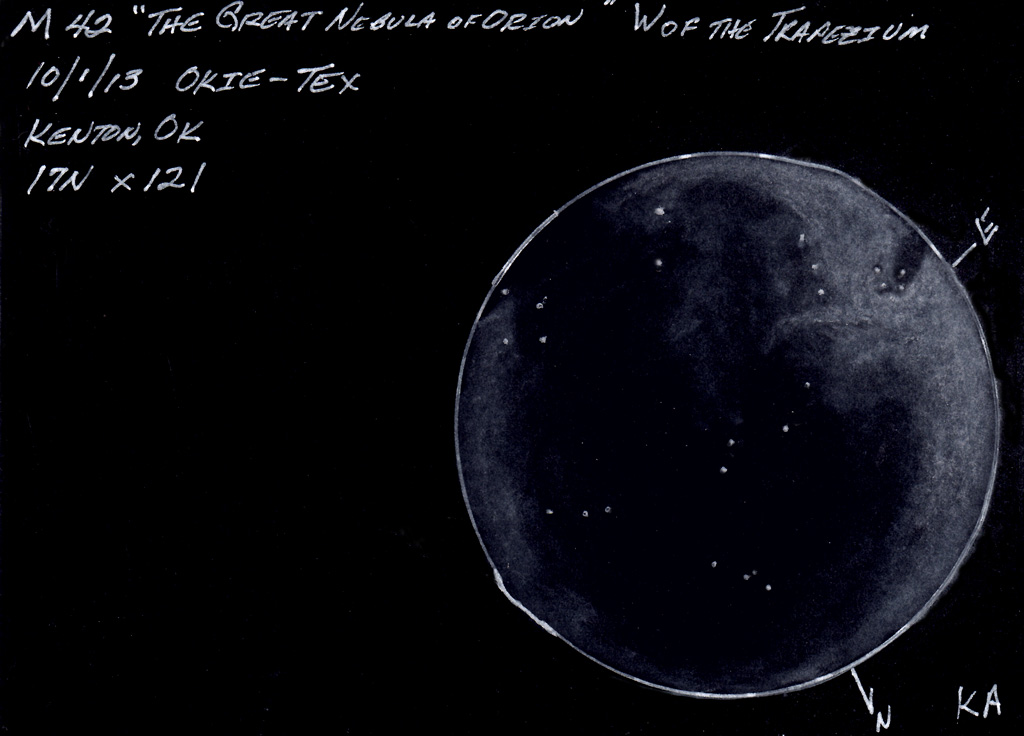
Object : M42 (West of Trapezium)
Object Type: Emission Nebula
Location: Kenton, OK (Okie-Tex Star Party)
Date: 10 October 2013, 0300 MDT
Media: Black paper, conte crayon, pencil and pen
Note: I liked the way the 17mm eyepiece framed this portion of the nebula. It looked, to me, like a wreath.
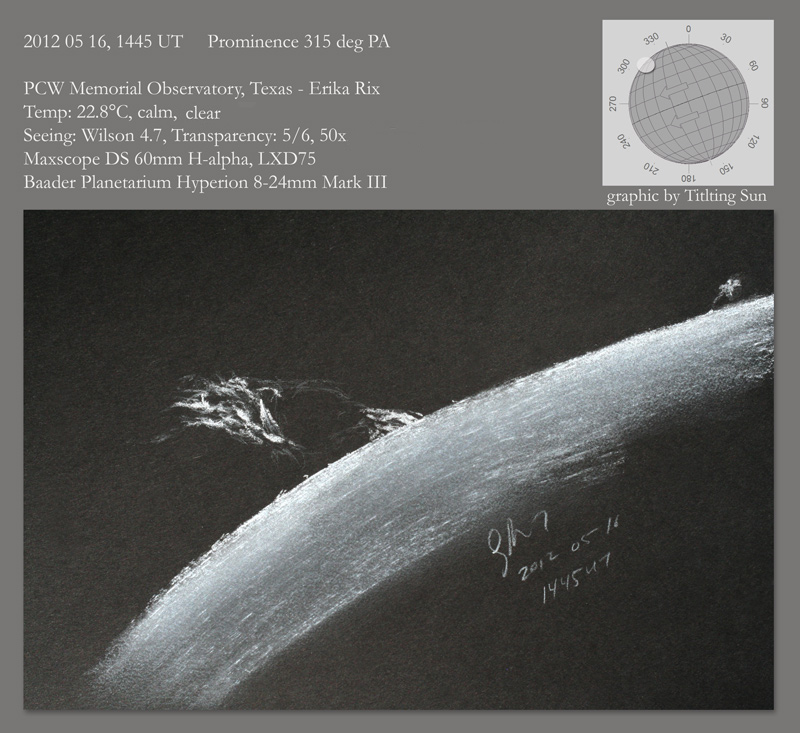
2012 05 16, 1300 – 1600 UT .
NOAAs 11476, 11477, 11478, 11479, 11481, 11482, 11484, 11485.
PCW Memorial Observatory, Texas – Erika Rix
www.pcwobservatory.com
Temp: 17.2°-27.8C, calm-N 5mph, clear.
Seeing: Wilson 4.8-4.6, Transparency: 5/6, 50x.
Maxscope DS 60mm H-alpha, LXD75, Baader Planetarium Hyperion 8-24mm Mark III.
Sketches created at the eyepiece with black Strathmore Artagain paper, white Conte’ crayon and pencil, white Prang color pencil, Derwent charcoal pencil, black oil pencil.
As of this morning, there were 8 active regions on the Sun. Plage and filaments scattered over three quarters of the solar disk with sunspots popping in and out of view crisply as it moved in and out of the scope’s sweet spot. A large diffuse quiet region filament, similar to the one observed on May 6, 2012, was to the SE quadrant reaching out over the limb. Two large bright prominences were located at PA 70 and 115 with several smaller ones scattered around the limb. The prom at 70 degrees had very faint wisps of structure reaching between the three brightest regions.
I had started to draw the full solar disk when a faint pair of prominences to the NW caught my eye. I had accidentally kicked the adaptor that was plugged into my power pack and the mount turned off, allowing the disk to drift across my field of view. When this happened, a huge billow of plasma floated above the limb. It was attached by very slender lines of plasma to the thick fainter prom at the 315 degrees position angle. It had the appearance of a large balloon being blown to the south while tethered to the ground. Tossing my larger sketchpad to the side, I grabbed the smaller pad and quickly sketched this prom. As the course this morning’s observation went on, the billowed top of the prominence changed quite dramatically. I almost expected it to either break free or collapse on itself before my session ended but by the time I completed the full disk sketch, it was still there.
The prominences near 1476 were dense and compact. The plage was very brightly formed as several slender lines within that active region. The main sunspot in 1476 was very easy to spot in h-alpha although the ARFs were very thin and few.
1479 is reminiscent of 1476 several days ago, although the preceding spot standing alone is on the opposite end. Of course, another difference that the sunspots in 1479 are smaller. They may develop more as the days go on. Here’s hoping for beautiful weather so we can keep an eye on it.
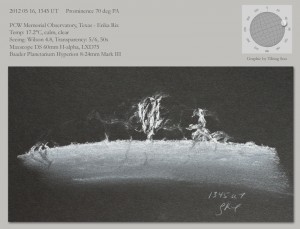
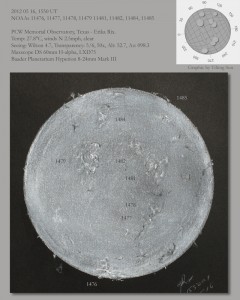
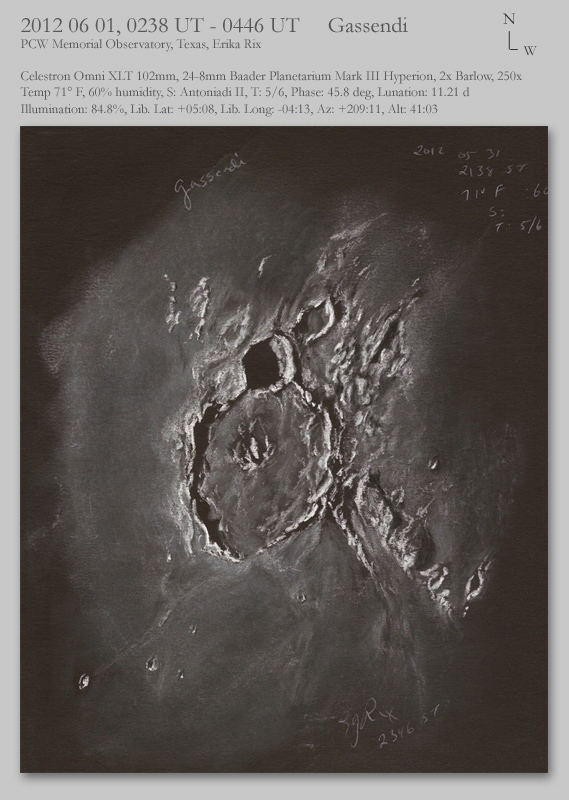
Gassendi Crater
Move cursor over image to view labels.
2012 06 01, 0238 UT – 0446 UT Gassendi
PCW Memorial Observatory, Texas, Erika Rix
www.pcwobservatory.com
Celestron Omni XLT 102mm, 24-8mm Baader Planetarium Mark III Hyperion, 2x Barlow, 250x
Temp 71° F, 60% humidity, S: Antoniadi II, T: 5/6
Eyepiece sketch black Strathmore Artagain paper, Conte crayon and pastel pencil, charcoal pencil
Phase: 45.8 deg, Lunation: 11.21 d, Illumination: 84.8%
Lib. Lat: +05:08, Lib. Long: -04:13
Az: +209:11, Alt: 41:03
Located on the northern border of Mare Humorum, crater Gassendi is an impact crater formed during the Nectarian period (-3.92 to 3.85 billion years ago) that later was modified after volcanic activity, becoming a fractured-floor crater. Gassendi is believed to have been filled with lava from the inside, raising its floor, creating stress fractures in the process. This would explain it being considered a walled plain with a shallow depth of 2.8 km. The central peaks (~1200 m high) remain and several rilles (called Rimae Gassendi) were formed on the lava-filled floor during the Imbrian geological period -3.85 to –3.2 billion years ago.
Crater Gassendi A was formed during the Copernician period (–1.1 billion years ago to the present day) and overlaps Gassendi’s northern rim. The pairing of Gassendi and Gassendi A resembles a diamond ring and makes a very striking feature to observe 3 days after first quarter or two days after last quarter of lunation. My observation was nearly three days after first quarter.
Gassendi’s southern rim was swallowed by the lava of Mare Humorum leaving only a thin crest line to support its circular shape. Dorsa ran from the southern rim to Gassendi O (11 km wide). The sharp ridge that defines the border of Mare Humorum to the SW of Gassendi adds to the crater’s unmistakable identification.
At the beginning of my session, Spica and Saturn lined up to align with the Moon. Spica was 2.08 degrees north of the Moon and Saturn was 6.9 degrees north of the Moon. Extending further north, Arcturus was nearly in line as well at 31.8 degrees north of the Moon
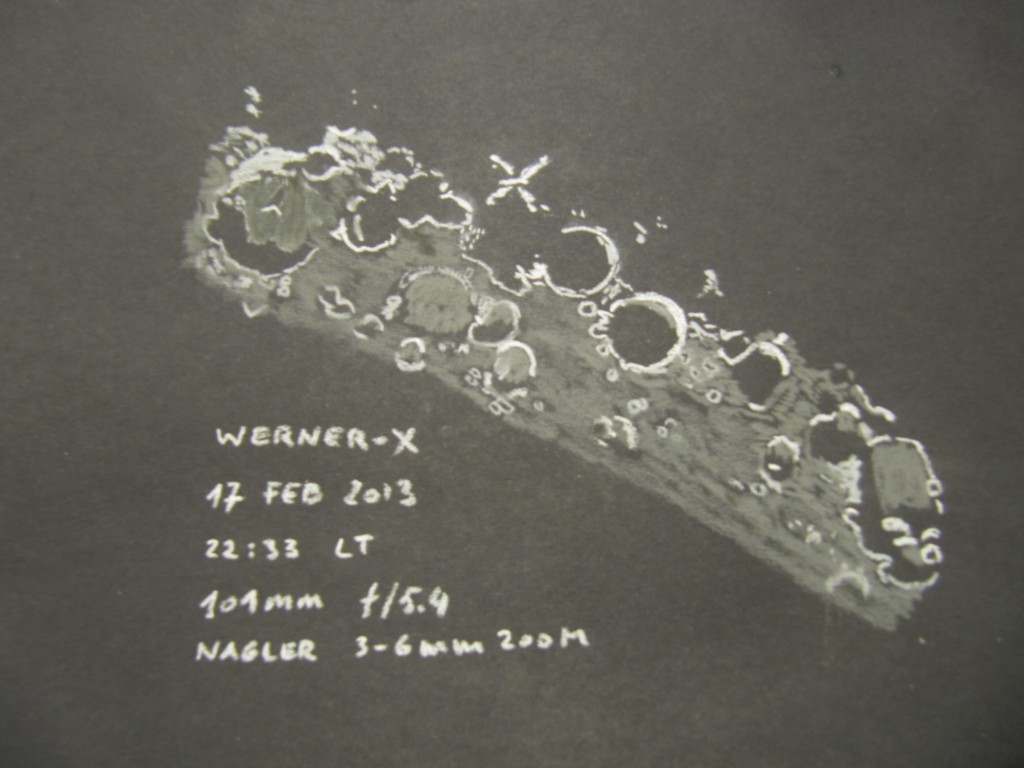
hi, we ‘re facing another long period with really bad conditions for our hobby, here in Belgium. We exactly had 2 clear nights in the past 3 months. No good at all. But we were lucky yesterday. Clear skies and … exactly when Werner’s X is about to appear. Half past ten PM (22u33) local time, the X appeared slowly. The sketch was made with Conté pastel on black paper.
Equipment used: Tele Vue 101 SDF on Tele Vue Gibraltar mount. Indeed the way Steven O’Meara used to work for his books. Tele Vue Nagler Zoom 3-6mm. No filters used.
Thanks,
/Erik

Mare Crisium – Hover mouse over image to view labels
Mare Crisium is that interesting isolated sea on the northeastern side of the visible lunar surface. Not long before beginning the sketch, it became fully illuminated.
The Nectarian Period impact event that formed this feature occurred more than 3.8 billion years ago. The mare portion of the basin is about 500 kilometers across. In the grazing sunlight on the floor, wrinkled ridges were visible. Also on the western floor craters Picard (24 km.), Peirce (19 km.) and Swift (11km.) stood out in the low light. I could see the lighter gray bench lava that partly buried craters here such as Yerkes (37 km.). Tall flat top mountains (massifs) beyond the shore stand at 2-5 kilometers above the sea. Both promontoria Lavinium and Olivium stood out clearly in very brief moments.
Sketching:
For this sketch I used: 400 series black Strathmore Artagain paper 9″x 9″, white and black Conte’
pastel pencils , and Conte’crayons, a blending stump, plastic eraser.
Telescope: 13.1 inch f/ 6 Dobsonian with 6mm (332x)
Date: 2-13 & 14-2013 23:00 – 00:45 UT
Temperature: 1.7°C (35°F)
Weather: clear, calm
Seeing: not good Antoniadi IV
Co longitude: 310.9°
Lunation: 3.69 days
Illumination: 15.7%
Frank McCabe

The southern lunar highlands expose the ancient anorthositic crust between craters. Centered in this southern highland sketch is the buried pre-Imbrian crater Heraclitus (92 km.) with its unusual central mountain crest. This ridge or crest looks much like the one on the floor of the elongated crater Schiller formed during its shallow angle impact. The ends of Heraclitus are buried under Licetus (77 km.) to the north and Heraclitus D (52 km.) to the south. Its easy to imagine this possible Schiller twin here partly hidden. To the east is crater Cuvier (76 km.) with its smooth floor and western wall pressing in on Heraclitus.
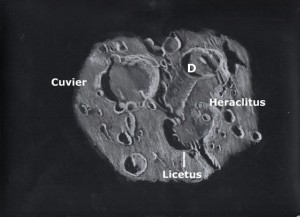
Sketching:
For this sketch I used: black Canson paper 9″x 12″, white and black Conte’ pastel pencils and blending stumps. The scanned sketch is unmodified
Telescope: 10 inch f/ 5.7 Dobsonian and 4 mm eyepiece 362x
Date: 09-24-2012, 00:15 – 01:50 UT
Temperature: 10°C (50° F)
clear, calm
Seeing: average Antoniadi III
Colongitude 11.3 °
Lunation 7.9 days
Illumination: 63.5 %
Frank McCabe

M20 (BN/DN in Sgr)
Location : Mt. Bo-Hyun, South Korea (1,100M)
Date : May/27/2012
Media : Black paper, White Pastel / Conte
Equipment : Discovery 15″ Dob, Pentax XL 14mm
Hi. ASOD and everyone.
Last May, the latitude of the M20 is enough than I think. So I observe the Trifid nebula. The most distinctive appearance is the asymmetric three-pronged dark lane and the two fuzzy star located in the middle of the nebula.
—-
조 강 욱 / Kang Uk, Cho